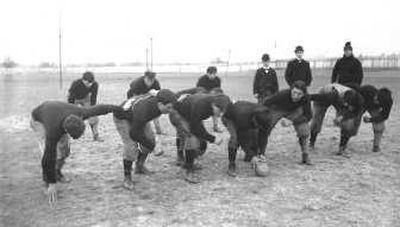Gridiron heroes

PHILADELPHIA – Chippewa and Iroquois, Cherokee and Cheyenne, they were pulled from the reservations to take part in a brutal experiment in education at the hands of an Army captain who strove to blot out their cultural identity.
But on the football field, they were fleet and innovative, able to compete with and defeat the white man at his own game.
In her new book, “The Real All Americans: The Team that Changed a Game, a People, a Nation,” Washington Post columnist Sally Jenkins recounts in rich detail the triumphant – and often overlooked – history of the Carlisle Indians, a series of ragtag teams of Native Americans from a tiny school in central Pennsylvania that regularly bested the moneyed powerhouses of football’s formative years.
The book opens as the Carlisle Indian Industrial School prepares for a showdown with Army in 1912 – 22 years after Wounded Knee. Jenkins recounts a speech given by Glenn S. “Pop” Warner, Carlisle’s coach for 13 seasons, in which he tells his players to “just go to your rooms and read your history books.”
And what follows is a history, not just of Carlisle’s great teams but also of the latter years of the country’s great western expansion. Jenkins uses the Carlisle teams to open a window onto the conflicts that eventually subdued American Indians following the Civil War and the attempts to integrate them into white society toward the start of World War I.
“I wanted to use the story as a way into Native American assimilation,” Jenkins said. “I thought that the narrative story of that was really fascinating.”
Jenkins begins her account of Carlisle’s history with the story of Richard Henry Pratt, a young cavalry officer who went on to found Carlisle and served as its superintendent for more than 20 years. Pratt is the dominant figure of the first half of the book, simultaneously paternalistic and despicable for his attempts to “civilize” his young charges.
To modern sensibilities, Pratt is difficult to understand. He was a constitutional literalist who objected to the mistreatment of American Indians and advocated for their rights, but required arriving students to have their braids cut off and dress in military-style uniforms in an effort to grind out their heritage.
Football doesn’t make much of an appearance until midway through the book when Pratt, realizing it could be a positive way to showcase the school’s accomplishments, allows his students to take up the game that is capturing the nation’s attention.
And those teams, though usually outsized and outnumbered, soon found success on the football field.
“The Carlisle Indians fought the frontier wars all over again in the stadiums of Victorian America and had a much better outcome the second time around,” Jenkins said.
John Sayle Watterson, an author and sports historian who teaches at James Madison University in Harrisonburg, Va., praised Jenkins for including so much historical background, although he disagreed with her portrayal of President Theodore Roosevelt’s role in the rule changes that curbed the game’s brutality.
“The unusual thing is tying it into the demise of the Plains Indians and the attempt to make the Indians into whites by these schools that were set up in many places,” said Watterson, who read excerpts published in Sports Illustrated. “Tying it into that is really kind of a remarkable achievement.”
On the field, Carlisle faced many of the same crooked dealings they had come to expect from the federal government. At one point, they were even swindled by one of their early coaches, a Yale University alum who was acting as an official in a game against his alma mater.
Yet the Indians found creative ways – from a hidden-ball trick to embracing the rule change legalizing the forward pass – to triumph over their bigger opponents and earn the grudging respect of a society still clinging to racist stereotypes.
“It’s amazing how innovative that team was,” Jenkins said. “Everything that’s fun in the game today really came from Carlisle.”
It was on the practice field at Carlisle – the one the players seeded themselves – that Warner developed the single wing, the offensive scheme that would dominate football in the years following the legalization of the forward pass. Using the revolutionary new offense, Carlisle would employ myriad fakes, bootlegs and reverses that still appear in modern playbooks. They even ran an early version of the hurry-up offense and perfected one of the first downfield passing attacks.
And it was against Army in 1912 that Warner unveiled the next evolution of his offense, the double wing. As a contemporary newspaper account observed, “The shifting, puzzling, dazzling attack of the Carlisle Indians had the Cadets bordering on a panic.”
Carlisle would win 27-6.
The book also touches on the well-trod ground of most biographies on Carlisle’s most famous alum, Jim Thorpe, who spent a total of seven years at Carlisle: his wild childhood and arrival at Carlisle, the loss of both of his parents before his 16th birthday and his exploits on the football field and the track. Jenkins recounts Thorpe’s Olympic accomplishments – winning the pentathlon and decathlon at the 1912 games – and the ensuing scandal over his time as a semipro baseball player during a two-year hiatus from the school that resulted in him being stripped of his medals.
One of the few times Jenkins deviates from her narrative is to point out that college sports still struggle with the notion of amateurism.
“It’s interesting to me that they still haven’t resolved that question,” Jenkins said. “Amateurism really is still torturing the NCAA. When you read back about the Thorpe case and you read the newspaper accounts, it’s very startling how much of that stuff we’re still trying to hash out.”